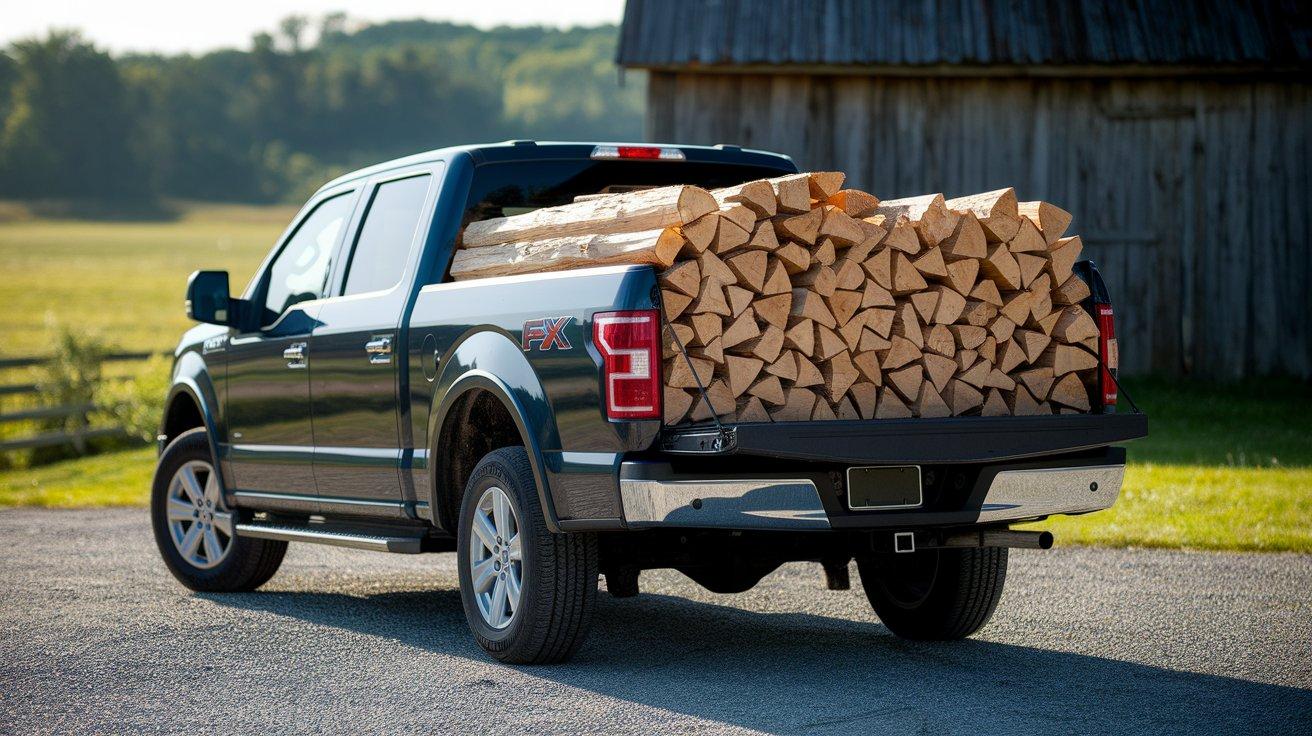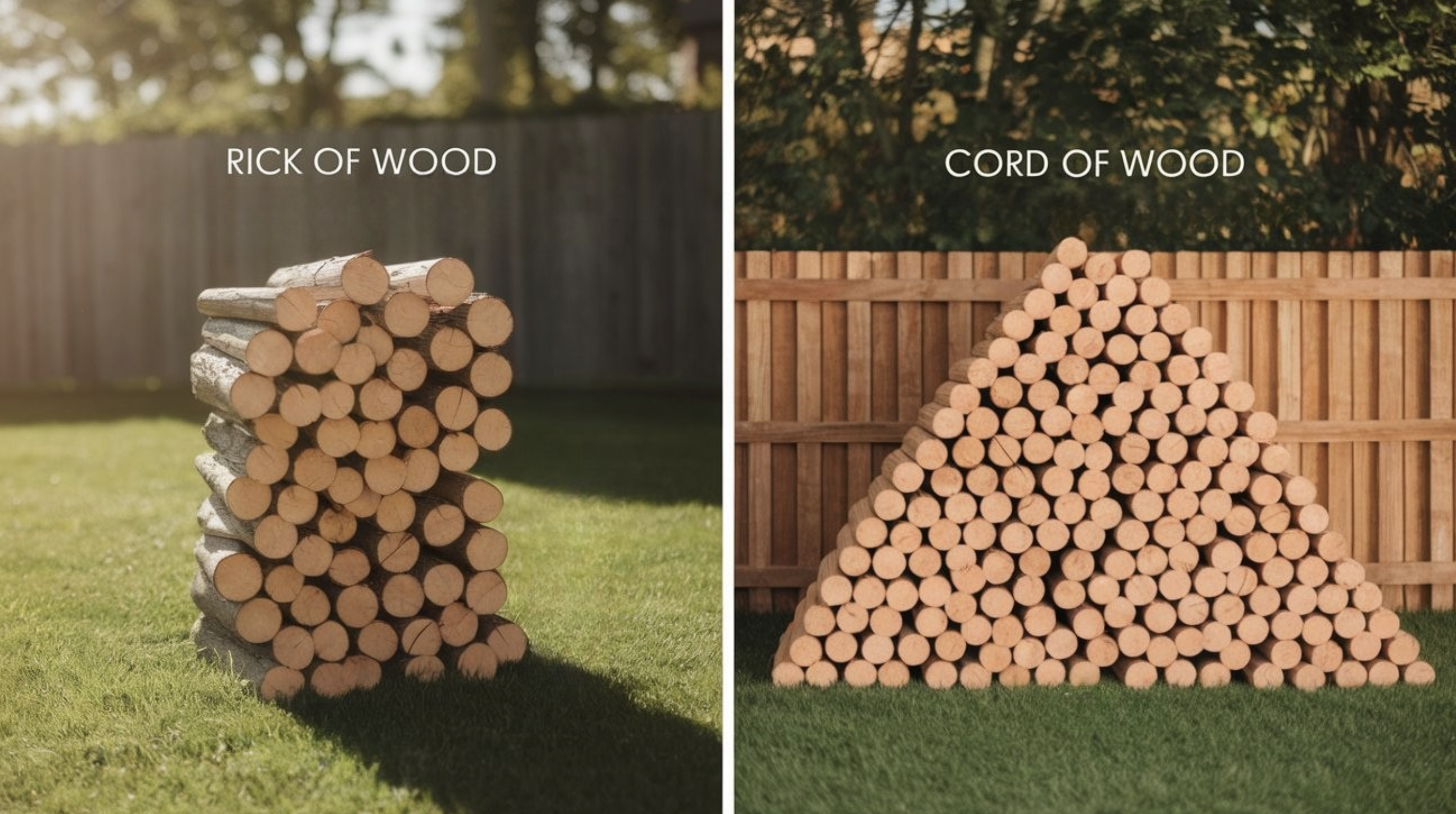Feeling cold during winter nights but unsure how much firewood to order?
A rick of wood might be what you need. Many homeowners struggle with understanding wood measurements, often paying too much or getting too little for their heating needs.
I’ve found that knowing the exact size of a rick helps you budget better and plan your winter heating. No more last-minute wood orders during snowstorms!
In this blog, I’ll explain what a rick of wood actually is, its standard measurements, and how it differs from a cord. You’ll also learn practical tips for storage and efficient use to keep your home warm all winter long.
What Is a Rick of Wood?
A rick of wood is a stack of firewood with specific measurements. The term has been used for many years as a common unit for selling firewood in many areas.
Rick is often misunderstood because it’s not a standard measurement like a cord. It refers to a particular way of stacking wood with certain fixed and variable dimensions.
Key facts about a rick:
- It’s a stacked pile of wood with set dimensions
- The length and height are fixed, but the depth can change
- It’s smaller than a full cord of wood
- The term varies by region across the country
- Wood dealers use it as a common selling unit
How Big Is a Rick of Wood?
A rick of wood has standard measurements that you should know before purchasing. The usual size follows specific dimensions that are consistent in most regions, though some local variations exist. Understanding these measurements helps you know exactly what you’re buying and plan your storage space.
The standard rick is defined primarily by its height and length, with a variable depth that depends on the cut of the wood pieces. This makes it a somewhat flexible unit compared to other wood measurements.
Key dimensions of a rick include:
- Height: 4 feet (48 inches) from ground to top of the stack
- Length: 8 feet (96 inches) along the longest side of the pile
- Depth: Variable, typically 16-18 inches (the length of an average piece)
- A standard rick contains about 1/3 of a full cord of wood
- The stack forms a neat rectangle when properly arranged
- The width matches the length of individual wood pieces
- Total volume is approximately 42-48 cubic feet, depending on piece length
- When stacked tightly, it contains about 550-650 pieces of split wood
- The face measurement is 32 square feet (4 × 8)
The depth variation is important to note because it directly affects how much wood you receive. Always ask the seller about the exact piece length to know the true volume you’re purchasing.
Rick vs Cord: Understanding the Key Difference
A rick and a cord are both common units for measuring firewood, but they differ significantly in size, volume, and standardization. These differences affect pricing and storage requirements.
The cord is a legal measurement with precise dimensions that don’t change regardless of where you purchase. A rick is an informal measurement that varies depending on regional customs and the length of the pieces.
Main differences:
- A cord is 128 cubic feet (4 × 4 × 8) – a full, legally defined measurement
- A rick is typically 1/3 of a cord (about 42.7 cubic feet) – an informal but common unit
- Cords have fixed dimensions in all directions for consistent volume
- Ricks have variable depth based on wood piece length, affecting total volume
- Full cords require more storage space and are harder to transport
- Ricks are more manageable for homeowners with limited storage
| Measurement | Rick | Cord |
|---|---|---|
| Height | 4 ft | 4 ft |
| Length | 8 ft | 8 ft |
| Depth | 16-18 in | 4 ft |
| Volume | 43 cubic ft | 128 cubic ft |
| Price | Lower | Higher |
When shopping for firewood, always clarify whether you’re buying a rick or a cord to avoid surprises when the wood is delivered.
Some sellers might use these terms interchangeably or have their own local definitions, so asking about the exact stack dimensions is always a good practice.
How Much Wood Is in a Rick?
The amount of actual wood in a rick depends on several factors that affect its total volume. This question matters because it helps you plan how much wood you’ll need for the winter season.
The number of pieces, total weight, and burn time all vary based on how the wood is cut, stacked, and what type of trees it comes from.
Wood species makes a big difference in what you get from a rick. Oak and hickory provide more heat per piece than lighter woods like pine or poplar.
The moisture content also affects both weight and burn quality, with properly seasoned wood giving the best results for home heating.
Important considerations:
- A rick contains roughly 275-325 pieces of split wood
- It weighs approximately 1,400-1,600 pounds when seasoned
- The amount varies based on how tightly the wood is stacked
- Gaps between pieces reduce the total wood volume
- The species of wood affects weight and heating value
- Expect 12-16 hours of burn time per cubic foot
Will a Rick of Wood Fit in Your Pickup Truck?
Knowing whether you can transport a rick yourself saves money on delivery fees.

Transport considerations:
- A standard 6-foot truck bed can hold about half a rick
- Full-size 8-foot beds can handle most of a rick
- Small trucks (5-foot beds) might need two trips
- Weight can exceed 1,500 pounds, affecting truck capacity
- Stack wood carefully to prevent shifting during transit
- Consider truck suspension limits before loading
| Truck Type | Bed Length | Rick Capacity |
|---|---|---|
| Compact | 5-5.5 ft | 1/3 – 1/2 rick |
| Full-size | 6.5-7 ft |
1/2 – 2/3 rick |
| Long bed | 8 ft | Nearly full rick |
Tips for Storing Your Rick of Wood Properly
Proper storage keeps your wood dry and ready to burn when needed.
- Stack wood off the ground using pallets or blocks
- Create a slight lean against a stable structure
- Leave space between the stack and the walls for air flow
- Cover the top but leave the sides open for ventilation
- Place in a sunny location to aid continued drying
- Position away from your house to avoid pest issues
Using Your Firewood Efficiently
Get the most heat from your rick by using proper burning techniques.
- Burn only properly seasoned wood with less than 20% moisture
- Start fires with smaller pieces and add larger ones gradually
- Maintain a bed of hot coals for steady heat output
- Control airflow with dampers instead of overfilling
- Mix hardwoods and softwoods for optimal burning
- Use a moisture meter to check wood before burning
- Clean your chimney regularly to maintain a good draft
- Consider a high-efficiency wood stove to use less wood
Conclusion
Understanding a rick of wood helps you make smart heating choices. Now you know a rick measures 4 feet high, 8 feet long, with variable depth based on the wood pieces.
This knowledge helps you budget better, store properly, and use your wood wisely.
The right wood storage methods keep your firewood in good condition. By stacking off the ground, allowing air circulation, and protecting from rain, you’ll have quality fuel when needed.
For the best value, buy seasoned hardwoods and transport them yourself if possible. Follow the efficient burning tips to get more heat from less wood.
What wood heating questions do you still have? Let us know in the comments!
Frequently Asked Questions
How Long Should I Season a Rick of Wood Before Burning?
Season your rick for at least 6 months. Properly dried wood has under 20% moisture content, burns hotter, produces less smoke, and creates fewer creosote deposits.
Can I Store a Rick of Wood Inside My Garage?
It’s not recommended. Indoor storage can attract pests and create moisture problems. If necessary, only bring in small amounts as needed and inspect for insects first.
How Many Ricks Do I Need for An Average Winter?
For a typical home using wood as supplemental heat, 3-5 ricks is common. Primary wood heating might require 7-10 ricks depending on climate and stove efficiency.


